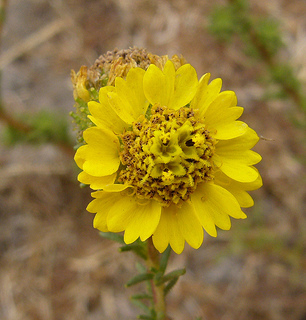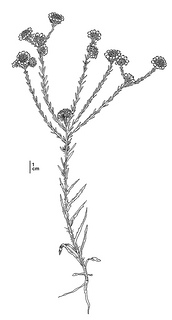(Holocarpha macradenia)
 Holocarpha macradenia. Photo © Zoya Akulova.
Holocarpha macradenia. Photo © Zoya Akulova.
 Holocarpha macradenia. CDFW illustration by Mary Ann Showers. (Click to enlarge)
Holocarpha macradenia. CDFW illustration by Mary Ann Showers. (Click to enlarge)
Santa Cruz tarplant is a California endangered plant species, which means that killing or possessing plants is prohibited by the California Endangered Species Act (CESA). The species is also listed as threatened under the federal Endangered Species Act. Santa Cruz tarplant is an herbaceous annual plant that grows between ten to fifty centimeters tall and has yellow, daisy-like flower heads. It is found in coastal terrace prairie habitat along California’s central coast, mostly in Santa Cruz and Contra Costa Counties, and typically blooms from June to October. Santa Cruz tarplant is self-incompatible, so it relies on pollinators to reproduce. As with other annual plants, Santa Cruz tarplant requires a stable seed bank for long-term and year-to-year survival. Research shows that annual population counts are often also improved when a properly-timed disturbance regime, such as mowing or grazing, is introduced to the ecosystem.
Historically, Santa Cruz tarplant habitat consisted of grasslands on coastal terraces below 100 meters from Monterey to Marin County. The availability of coastal prairie habitat has been significantly reduced due to grazing, non-native species, a disturbed fire regime, and agriculture. The California Natural Diversity Database estimates that only 800 hectares of intact coastal prairie habitat remains. In 2002, the U.S. Fish and Wildlife Service designated 2,902 acres of critical habitat for Santa Cruz tarplant within Contra Costa, Santa Cruz, and Monterey Counties. According to the designation, the primary threats to Santa Cruz tarplant are habitat destruction due to development and habitat alteration due to land management practices that allow other plants to outcompete Santa Cruz tarplant. Habitat that has been preserved is also threatened by recreational use, invasive species, lack of management, and changes in hydrology of surrounding areas.
At the time of this webpage posting, there were 17 occurrences of Santa Cruz tarplant presumed to still exist in CDFW’s California Natural Diversity Database. Four of those occurrences are reintroductions to one area at Wildcat Canyon Ecological Reserve, and the rest of the occurrences are naturally occurring populations, mostly on privately owned land. The four reintroduced occurrences are what remain from a larger reintroduction effort at several reserves and open spaces. Most of these reintroduced populations were unsuccessful within a few years, and results from the studies of these efforts indicate that reintroduction is not a viable form of mitigation for loss of natural Santa Cruz tarplant occurrences, largely because it is very difficult to establish an effective seed bank at a reintroduction site. In order to ensure the existence of Santa Cruz tarplant in the future, natural populations should be protected either by conservation easements or habitat acquisition. Additionally, management plans should be written and implemented to ensure ideal habitat conditions for reproduction and seed bank persistence. Invasive species encroachment should be managed, and more research should be conducted to assess the factors involved in effective seed bank production of successful populations.
CDFW may issue permits for Santa Cruz tarplant pursuant to CESA, and you can learn more about the California laws protecting Santa Cruz tarplant and other California native plants. Populations of Santa Cruz tarplant occur in CDFW’s Bay Delta and Central Regions. More information is also available from the U.S. Fish and Wildlife Service Species Profile for Santa Cruz Tarplant.
Updated 01/14/2014